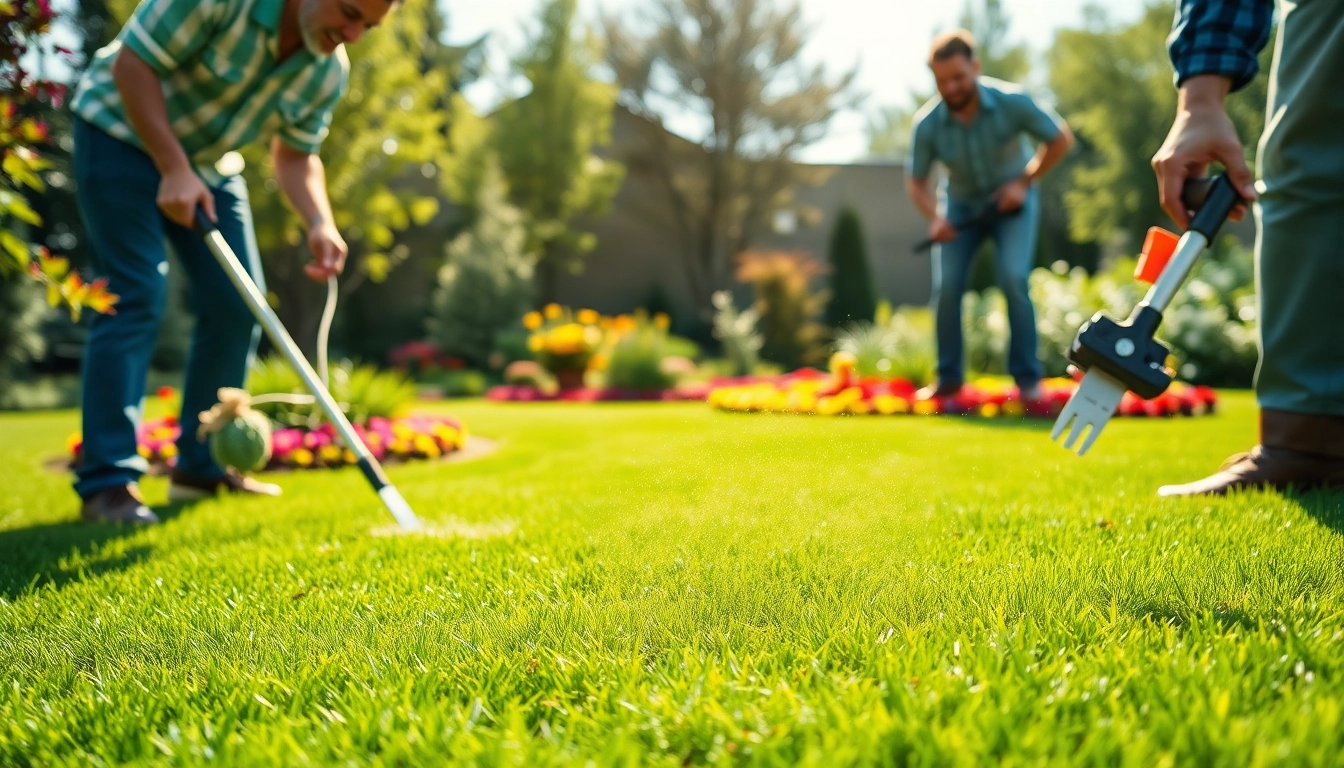Understanding Turf Maintenance Service
What is Turf Maintenance Service?
Turf maintenance service refers to the range of activities and practices executed to maintain and enhance the health and aesthetics of grassed areas. This includes regular mowing, fertilization, aeration, pest control, and irrigation, among others. Proper turf maintenance ensures that lawns and sports fields not only look vibrant and green but also promote healthy growth, improve resilience against disease, and contribute to environmental sustainability.
Importance of Regular Maintenance
Regular turf maintenance is crucial for several reasons. Firstly, it enhances the appearance of lawns and sports fields, creating an inviting atmosphere for residential and commercial properties. Secondly, a well-maintained turf can significantly increase the lifespan of the grass, reducing the need for reseeding and other costly interventions. Furthermore, regular maintenance practices such as aeration and overseeding improve soil structure and nutrient availability, fostering a healthier ecosystem for both grass and surrounding plants.
Moreover, engaging in comprehensive turf maintenance service minimizes weed infestation, pest problems, and diseases, promoting overall landscape health. Overall, the sum of these practices converges into practical benefits; they provide ecological advantages and improve the usability of outdoor spaces.
Common Myths About Turf Care
Despite the widespread need for and understanding of turf maintenance, several myths hinder effective care. One common myth is that all grass types require the same maintenance standards. In reality, different types of grass have unique requirements for sunlight, water, and nutrient intake.
Another myth is that a lawn only needs care during the growing season. However, the off-season is also crucial for preparations such as aeration and fertilization, which set the stage for healthy growth in the spring. Additionally, some people believe that frequent watering is always beneficial. On the contrary, over-watering can lead to shallow root systems and increased susceptibility to disease.
Best Practices for Turf Maintenance Service
Essential Tools and Equipment
To efficiently uphold turf maintenance, certain tools are indispensable. A sharp, high-quality mower is fundamental for keeping grass at the optimal height. Specialized tools for trimming and edging also ensure clean lines and a manicured look. For aeration, mechanical aerators help alleviate soil compaction and allow for air, nutrients, and water to penetrate the soil more effectively.
Additionally, spreading equipment for fertilizer and seed application ensures even coverage and optimal growth conditions. Weed control tools, including herbicide applicators and hand-pulling equipment, are necessary for managing unwanted plants without harming the turf. Finally, irrigation systems, whether automatic or manual, are vital for supplying the right amount of water, especially in regions with variable rainfall.
When to Choose Professional Help
Choosing to hire a professional for turf maintenance can be beneficial for both time management and expertise. Individuals often struggle with effective pest and disease identification, which professional services excel at. Furthermore, experts can conduct thorough soil tests to tailor fertilization and treatment plans specifically to the grass type and environmental conditions.
Additionally, if turf maintenance feels overwhelming due to size, time constraints, or lack of knowledge, enlisting a professional team can relieve those burdens. This ensures high-quality maintenance, allowing for consistent care, which may ultimately result in a stronger, healthier lawn or field.
Seasonal Maintenance Checklist
Effective turf maintenance varies by season; thus, having a seasonal checklist allows for organized and thorough care. In spring, core aeration, overseeding, and applying a starter fertilizer are valuable steps. Summer typically requires consistent mowing, irrigation management, and disease monitoring to prevent heat stress.
In the fall, it’s time to prepare for winter through strategies like applying winter fertilizers, seeding for fall growth, and addressing any pest infestations. Finally, winter preparations can involve soil testing and equipment maintenance to ensure readiness for spring. Adhering to these seasonal practices offers vitality to the turf all year round.
Common Challenges in Turf Maintenance Service
Pest Management Strategies
Pest infestations can severely damage turf quality and appearance. Being proactive is essential in managing these threats, with strategies ranging from natural remedies to chemical pesticides. Integrated Pest Management (IPM) is a recommended approach where various tools and practices are combined for effective control. This includes monitoring pest populations, applying beneficial insects, and using cultural practices that minimize pest attraction.
It’s also important to identify pests accurately as some may appear similar. For instance, knowing the difference between grubs and beetles allows for targeted treatment, which can conserve beneficial insects that would otherwise be harmed by broad-spectrum pesticides. Keeping a record of pest activity can also aid in timing treatments for maximum effectiveness.
Dealing with Weeds Effectively
Weeds pose a significant challenge to turf health by competing for resources. Effective weed management begins with prevention, which can be achieved through proper turf care, including regular mowing and healthy soil practices. Identifying common weeds in the area helps in selecting the appropriate strategies for eradication, which may include cultural practices, mechanical removal, and selective herbicides.
A pre-emergent herbicide can be applied in early spring to prevent weed seeds from germinating, while post-emergent herbicides can be used to target established weeds. Additionally, maintaining a thick, healthy lawn can naturally deter weeds, as a dense turf canopy reduces available sunlight for them to thrive.
Addressing Nutrient Deficiencies
Soil nutrient deficiencies can manifest as yellowing grass, poor growth, or increased susceptibility to disease. Conducting regular soil tests allows for the identification of these deficiencies and can guide fertilization efforts. Essential nutrients for healthy grass include nitrogen, phosphorus, and potassium; however, micronutrients such as iron and magnesium also play significant roles.
After identifying nutrient needs, applying the right type of fertilizer at the recommended rates is paramount. Timing also matters; for example, nitrogen is typically best applied in spring and early fall when grass is actively growing. Balancing these nutrient applications creates a robust lawn, resilient to pests and environmental stress.
Advanced Techniques in Turf Maintenance Service
Soil Aeration Methods
Soil compaction is detrimental as it restricts root growth and limits the water-holding capacity of the soil. Aeration methods, such as core aeration, perforate the soil, allowing air, water, and nutrients to reach grass roots more efficiently. This technique improves overall soil structure and promotes deeper root growth.
Different mechanical aerators, including spike aerators and plug aerators, serve varied purposes depending on the soil conditions and the type of turf. Timing is essential, with fall and spring generally being the most effective periods for aeration to rejuvenate the turf.
Overseeding for Healthier Grass
Overseeding is the practice of sowing grass seed into existing turf to enhance density, improve color, and fill in bare patches. This method is especially useful for rejuvenating lawns suffering from thinning or disease. Selecting a compatible seed mix that matches the existing grass type maximizes integration and improves overall terrain resilience.
It’s best to overseed during the cool seasons when the soil is suitable for germination. Following up with a light top-dressing of compost helps enhance seed-to-soil contact and provides vital nutrients for new seedlings.
Implementing an Irrigation Schedule
Water management is a crucial aspect of effective turf maintenance. Implementing an irrigation schedule ensures that grass receives adequate hydration without over-watering, which can lead to shallow roots and disease. The schedule should reflect seasonal changes and weather conditions, generally aiming for about 1 to 1.5 inches of water per week, adjusting based on rainfall and temperature variations.
Smart irrigation systems, equipped with rain sensors and soil moisture technology, can further streamline this process, making adjustments automatically based on current environmental conditions, promoting water conservation while ensuring turf health.
Measuring Success in Turf Maintenance Service
Key Performance Indicators to Track
Tracking performance indicators is essential to gauge the success of turf maintenance strategies. Key indicators include turf density, color consistency, and the incidence of pests and diseases. Regular site assessments should monitor these factors over time, allowing for strategic adjustments in maintenance methods.
Additionally, measuring soil health through pH and nutrient levels, along with the effectiveness of irrigation techniques, provides insight into overall turf viability. Documenting these metrics over seasons offers a comprehensive view of the effectiveness of implemented strategies.
Customer Satisfaction and Feedback
For those offering turf maintenance services, customer feedback plays a vital role in measuring success. Engaging with clients to assess their satisfaction with both the results and the service experience can yield invaluable insights. Surveys, follow-up visits, and open communication channels can strengthen relationships and improve service delivery standards.
Incorporating client feedback into service processes allows for continued improvement, ensuring customer retention and positive referrals, contributing to long-term business success.
Adjusting Strategies Based on Performance
Adaptability in turf maintenance service is crucial for maximizing outcomes. Consistently analyzing performance data against established goals enables practitioners to adjust their strategies effectively. For example, if a particular fertilization method is not yielding expected results, experimenting with alternative products or application rates may be necessary.
Additionally, staying informed on the latest turf care research and hiring trends in soil science allows maintenance providers to adopt innovative solutions that can enhance turf vigor and resistance to environmental stressors. A commitment to ongoing education thus plays a pivotal role in optimizing turf maintenance results.



